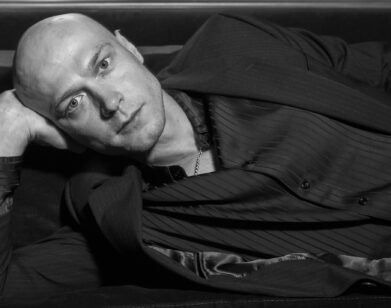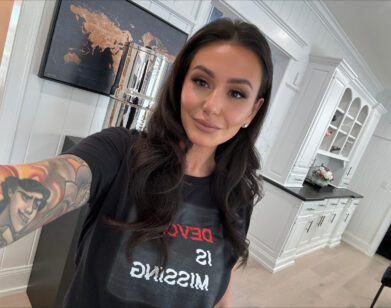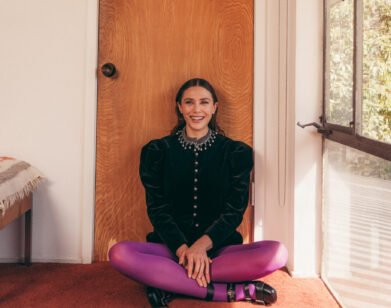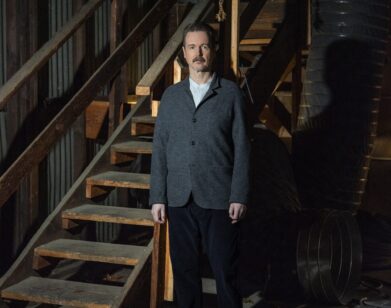Amy Berg and the Little Girl Blue
AMY BERG IN NEW YORK, NOVEMBER 2015. PHOTO:MARK DAVIS.
Since 2006, Amy Berg has completed five feature-length documentaries and narrative films, during nearly all of which she’s been working on her much-anticipated Janis Joplin documentary. Berg was first approached by Joplin’s estate, which, working with a financier and producer, auditioned various filmmakers and interviewed them for the coveted gig. She landed the job. Eight years down the road, both late and over-budget yet eminently worth the wait, Janis: Little Girl Blue has finally emerged into the world, giving voice to a singer who’s been much mythologized and canonized. Janis dwells on lengthy passages of live performance, of music, of Joplin jamming with friends, interspersed with commentary from those who knew her best. But the main event is the archival footage: “I wanted it to feel like a concert,” Berg tells us. From behind-the-scenes moments of Joplin playing bluegrass covers with her band on the road to her iconic Monterey Pop set, she speaks from the ether through her music.
She also speaks through a set of letters Berg obtained from the estate. Joplin’s letters narrate the length of Janis—the first scene features a recording of Joplin reading one of her own letters, but the husky voice that gives voice to the rest of the film belongs to Chan Marshall, alias Cat Power. Marshall’s voice is a dead-ringer for Joplin, and it’s fortuitous for Berg to have stumbled across a fellow musician whose work has undoubtedly been influenced by Joplin.
It would be easy to spend hours and paragraphs discussing Berg’s work on Janis alone, and she herself leaps into discussions of this film with an energy that isn’t readily evident when she mentions other films. “I don’t know if it’s because I love her so much that the films works,” she confesses, “but other people like it, so I’m happy with it.” Despite the lengthy process and exceeded budget, Berg says she still finds places where she would fiddle with the film, were she to make another documentary. “The real director’s cut would be the one where I don’t have to worry about how much I’m paying for the archive footage,” she says. “I just wanted to see Janis the whole time.”
That’s not to gloss over Berg’s previous work. Her 2006 documentary Deliver Us From Evil (not to be confused with the 2014 Eric Bana film of the same name), about a California priest who molested children in his parish and fled to Ireland under the church’s protection, was nominated for the Academy Award for Best Feature Documentary. Her subsequent films, including West of Memphis (2012), An Open Secret (2014), and Prophet’s Prey (2015), have similarly focused on issues surrounding exploitation and social justice. She’s tackled subjects like child abuse, criminal justice, and cult leadership. But when we sat down with Berg in early November to discuss Janis, it was music that was on our minds.
KATHERINE CUSUMANO: So why Janis?
AMY BERG: Well, why not Janis? [laughs] Janis deserves to have a proper film about her. I think that her legacy up to this point has been more about her death than her life, and I wanted to make sure people got the full sense of who Janis was as a woman, as a rock star. She was the first woman of rock ‘n’ roll, essentially, and she broke through so many different walls to pave a path for women to walk on today. She had a direct impact on the women’s movement in a different way than we talk about in history. She was a feminist without having to say she was a feminist.
CUSUMANO: The feminism comes through just in the way that she conducted herself.
BERG: Yeah, she didn’t shave her armpits, she didn’t wear a bra, and she was as ballsy as could be on stage. Like every woman, she wanted it all and she wanted to find a way to have it all. She was so authentic. There was nothing phony about her, and she just gave it her all. I think it still resonates in such a strong way. I think her music is timeless; I don’t think it sounds dated.
I really love her and I think her story speaks to everyone for a different reason. Everyone sees a part of themselves in this movie, which is so amazing. People who don’t know anything about her, people who are huge fans of hers, women, filmmakers, singers, people that are just randomly connected based on one song that they like—she speaks to people for different reasons.
CUSUMANO: Did you go into this with an angle in mind?
BERG: I read the letters early on, and that was the angle that I wanted to take, to find a way to have Janis tell her own story. I didn’t know that much about her. I had read Buried Alive when I was a teenager, and I for sure was influenced by her music, but I didn’t know who Janis the woman was. That’s what I wanted to find out.
CUSUMANO: Trying to have Janis tell her story through her own words, but not having her around to tell it—how did you work around that?
BERG: I looked at everything; I read all of her letters; I spoke to her friends. I just tried to understand her the best way I could. I went in thinking that she was less sensitive. I went in with some clichés in my head. Those were erased after I spoke to people and kept hearing over and over the same kind of thematic stories. I realized early on that her legacy in my mind was wrong, and so I wanted to get it right.
CUSUMANO: Each person sort of had their perspective on who she was and what drove her. You get the impression that maybe no one person really knew her. Do you think that she really let any of those people in?
BERG: I think they all knew her differently, you’re right, but I think that some of the “differentlys” are different than the way that we expect to see Janis: Janis the musician; Janis the woman; Janis seeking validation; Janis who, every time she fell in love with somebody, she wanted to marry them. So they all had a different take on her but they all bonded with her in different ways.
CUSUMANO: Growing up loving her, were you sort of disenchanted in any way by what the research dug up? How did your perspective of her change?
BERG: I felt so bad for her because she never healed herself from her childhood. Everyone has shitty times in their twenties, you know? Your twenties are about trying to figure out what happened when you were a kid, and then you get through it and you start embracing who you are. The letter that I open the film with is so important to me because she’s trying to sooth herself in this letter. She’s taking stock of where she’s at—the line that really sticks out for me is “Need to be proud of myself,” because obviously everyone was proud of Janis, and she knew that. She wasn’t naïve, but she still wasn’t able to comfort herself. That is so sad to me, because I think that she would have gotten there. And 27 is the year of Saturn returns. Everything gets stirred up, and it gets crazy for people.
CUSUMANO: How do you balance documenting versus advocating for a particular stance on your subject?
BERG: We were talking about this at the Hollywood Reporter round table the other day, and I think it’s really important for me to articulate this—I don’t go into a documentary as an advocate. But you spend so much time with the subject, and you become so passionate about whatever that is that at the end of the day there is an expectation for a certain advocacy. Anything you become passionate about, it’s harder to let go of it when you finish the film. You emotionally get caught up in what you’re doing. It becomes impossible not to, because it becomes your whole world.
CUSUMANO: What’s the first thing you do when you think you’ve got an idea?
BERG: I have a very obsessive way about research, and I can’t stop going. I want to find out everything I can, read everything, and just start seeing it.
CUSUMANO: When do you start to think something will pan out?
BERG: I never think that it won’t. It’s kind of weird. I’ve had so many ideas that didn’t pan out, but I never really think that it won’t until something happens to push me away from it. I trust my instincts a lot on stories.
CUSUMANO: A lot of your previous work has focused on exploitation and sort of social justice issues. But you’ve been working on Janis alongside those the whole time. How does Janis fit into the rest of your work?
BERG: The role for me, same as every film I make, is to find the authentic voice for the narrative and stick with it all the way through the film. I think that the formative years are the most important for children. The idea that she was bullied and her confidence was taken away from her so many times when she was just trying to find her voice does connect with other stories that I’ve done. She was able to transform all of that pain into her art, and that’s a really important message. She was able to push this beautiful music out of such deep-rooted pain. You can see that transformation. That Monterey Pop scene is so important for me because you can see when she’s on that stage, she found herself.
CUSUMANO: There’s a great quote, “When the show’s over, the audience leaves and you’re left with yourself.” It seemed like that encapsulated the movie.
BERG: Totally. The theme of loneliness is a big one for Janis. When I interviewed Pink, she laid it out really well. She said when she’s on tour it’s just her and God and her 20- or 50-thousand fans, so she’s having this really out-of-body experience. Then she gets on the bus, and there’s a candle, a bottle of wine, and she looks at her watch and sees that she has to try to unwind, go to sleep, and get up and do the same thing again. How do you keep up with that pace?
CUSUMANO: Another thing that, looking through your filmography, ties them together is a really strong narrative. How do you apply the same storytelling principles?
BERG: Having access to emotional elements always ties it together. Even with Warren Jeffs [in Prophet’s Prey], it sounds twisted, but those prophecies that he was putting out, the combination of the prophecies and the music and the children’s voices, I feel like that emotionally pulls all the story points together, and I used that. The people that I was interviewing are so traumatized by their past—trying to tell the history through the people in the church was impossible. So I brought in Nick Cave and I wrote up a script and he read it. It told you everything you needed to know in less than a minute. It’s a combination of great elements, music, and visuals.
JANIS: LITTLE GIRL BLUE IS OUT THIS FRIDAY, NOVEMBER 27 AT THE IFC CENTER IN NEW YORK AND OTHER SELECT THEATERS.






